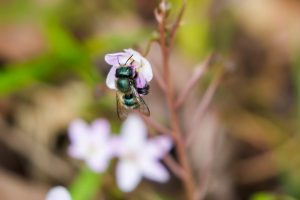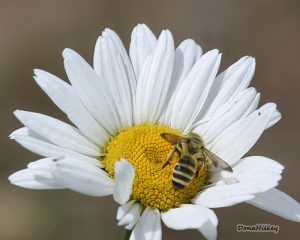When talking about bees, most people picture a fuzzy yellow and black-striped creature that lives in a busy hive with other worker bees and might sting you if you get too close. The western honeybee (Apis mellifera) is known for its integral role in our food and agricultural systems. Yet this type of bee is not native to the U.S. and is just one of 20,000 species worldwide. In fact, many native species don’t live in hives or even produce honey. Instead, they nest underground or in hollowed out twigs and stems, and provide vital pollination services to flowering plants and crops.
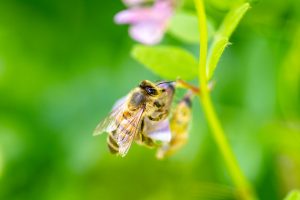
Bees and Our Food
The western honeybee was brought over from Europe sometime in the 17th century, presumably to support farming. Today, this species remains the most important pollinator agriculturally, producing an estimated
$14 billion worth of pollination services toward crop production. Native and unmanaged bees are important agriculturally as well, pollinating biofuel crops like canola and sunflower and contributing about $3 billion annually in domestic fruit and vegetable production.
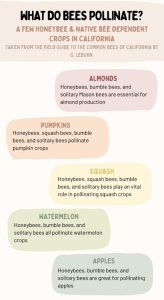
Why are Native Bees Important?
There are approximately 4,000 native bee species in North America, and about 1,500 of those have been observed here in California. While native bees do not necessarily have the same commercial value as the western honeybee, they are nonetheless essential to our ecosystems. Native bees and pollinators are crucial for pollinating native plants, which are well-adapted to our climate and serve as food and shelter for wildlife. Since about 70% of the world’s flowering plants cannot reproduce on their own, they rely on bees to pollinate them.
Both Mason bees (Osmia lignaria spp.) pictured at left and Miner bees (Andrena spp.) pictured at right are native to California. Mason bee photo courtesy of Melissa McMasters via Flickr Creative Commons. Miner bee photo courtesy of Dona Hilkey via Flickr Creative Commons
Unfortunately, bee populations in the U.S. have been declining steadily since the early 2000s. There are several factors affecting population loss, including pesticide use, habitat fragmentation, and habitat destruction. While this may seem alarming given the importance of pollinators in our daily lives, there are many steps individuals and communities can take to support pollinator habitat.
Pollinator Gardens Help Bee Populations
Pollinator habitats are possible in virtually any urban setting including parks, office parks, community gardens, and front yards. Any space where native plants can exist has the potential to be important pollinator habitat. Even just one plant can help bolster a connected network of pollinator habitat in a community.
Starting a Native Bee and Pollinator Garden
The Xerces Society for Invertebrate Conservation outlines three necessities when creating gardens for native bees and other pollinators: food in the form of abundant flowering plants, limited pesticide exposure, and adequate nesting and shelter sites.
When choosing native flowering plants for a pollinator garden, it’s important to consider the bloom time of each species. The plants you choose should bloom at different times of the year so that food sources are available to pollinators year-round. Make sure you have patches of exposed soil, which provides nesting sites for ground nesting and tunnel nesting bees.
There are a wide variety of resources to help you identify the right plants to add in a yard or community. For example, the Xerces Society website has free pollinator-friendly native plant lists that can be filtered by state and region. These lists also include bloom time, soil types, and water requirements for each species. Here on the Central Coast, California poppies, globe gilia, and lupines are excellent choices for supporting pollinators. If you have a lawn, consider replacing it with a native wildflower garden and then observe what local pollinators visit your home!
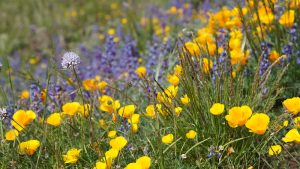
References
LeBuhn, Gretchen. Field guide to the common bees of California: Including bees of the Western United States. Berkeley, California: University of California Press, 2013.
LOSEY, JOHN E., and MACE VAUGHAN. “The Economic Value of Ecological Services Provided by Insects.” BioScience 56, no. 4 (2006): 311. https://doi.org/10.1641/0006-3568(2006)56[311:tevoes]2.0.co;2.
USGS. “Are Honey Bees Native to North America?” Are honey bees native to North America? . Accessed August 29, 2023. https://www.usgs.gov/faqs/are-honey-bees-native-north-america#:~:text=Honey%20bees%20are%20not%20native,crops%20like%20fruits%20and%20nuts.
The Xerces Society Guide. Attracting native pollinators: Protecting North America’s bees and butterflies. North Adams, Massachusetts: Storey Pub., 2011.
The Xerces Society. 100 plants to feed the bees. North Adams, Massachusetts: Storey Publishing Llc, 2016.
Help us protect and restore the Morro Bay estuary!
- Donate to the Estuary Program today and support our work in the field, the lab, and beyond.
The Estuary Program is a 501(c)3 nonprofit. We depend on funding from grants and generous donors to continue our work. - Support us by purchasing estuary-themed gear from ESTERO. This locally owned and operated company donates 20% of proceeds from its Estuary clothing line and 100% of Estuary decal proceeds to the Estuary Program. Thank you, ESTERO!
- Purchase items from the Estuary Program’s store on Zazzle. Zazzle prints and ships your items, and the Estuary Program receives 10% of the proceeds.
- Subscribe to our seasonal newsletter: Between the Tides!
- We want to hear from you! Please take a few minutes to fill out this short survey about what type of events you’d like to see from the Estuary Program. We appreciate your input!
